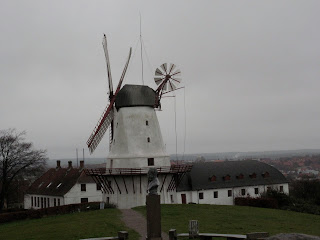While I was at the Sondbjerg estate I had the opportunity twice to go to a historical site in Denmark, called Dybbøl Mølle (Dybbøl mill). This mill is close to the Germany border and has been destroyed many times during wars with Germany.
Denmark is very proud of the Dybbøl mill because it is symbol of resistance and endurance.
" Dybbøl Mill emerges as the Danish-national symbol in the border country.
The mill was the center of fierce fighting in both 1848-49 and 1864.
During both the Schleswig wars of the mill was destroyed but re-built.
Dybbøl Mill and in extremely hot Dybbøl was the epitome of Danish resistance and endurance.
The mill and granary are decorated with exhibits that tell the story of Dybbøl a national symbol and remembrance site for two nations - Denmark and Germany."
 |
| Exhibits on the mill's history and significance somethings national symbol of Danish and German in 150 years. | | | | | |
Dybbøl Mill History
The windmill, built in
1744. In
1800 Lightning struck his mill burned down. The mile was rebuilt immediately thereafter. In both Schleswig wars of
1848-50 and
1864 the mill was destroyed and rebuilt. After
1864 and the Danish defeat by the Prussians, the mill was a symbol of Danish endurance in the lost land. In
1935 the mill burned down after a short circuit, but rebuilt in its present form.
Until
1990 the mill was powered by a number of tenants. In
1995, decorated Museum at Sønderborg Castle exhibitions in granary and mill.
 |
| Dybbøl mølle |
 |
| Dybbøl mølle |
 |
| This is a plaque was on the side of the mill. A colleague of mine who is Danish tried to translate it but it was difficult. She said the that words on the plaque were from old Danish. But she said that basically states this mill was raised from the ruble and this land stands for the brave Danish men you gave their lives. |
|
 |
| The view towards town. | |
|
 |
| More of the town Sondbjerb. |
|
|
 |
| Danish king Christian IX, who was king during the Second War of Schleswig in 1864. |
|
| Near by there is a flag pole with these three stones around it. Each stone had a message on it. I tried to translate the messages. |
 |
| Danish soldiers' associations raised this memorial honors those who fought for our motherland. |
 |
| Raised by the reunion of King Christian X in 1920. Christian X was Christian IX grandson. |
 |
Older Danish, the translation is kind of messy: but than are deer in the woods singing aloud waves the red flag than there is a god at the top which holds the UK Case.
Also that this site were a bunch of these cannons. Some of you might recognize these cannons I was standing near them in the family calender.
On the other side of the road you could still see the old battle line barracks.
This site is also really close to the ocean. It really is a beautiful site, of course both times I visited this location it was cold and very windy.
Thank you for all your love and support. |
|



















Thanks for all the great photos and explanations of your travels!! You and C must have really enjoyed the railway museum!!
ReplyDeleteDad